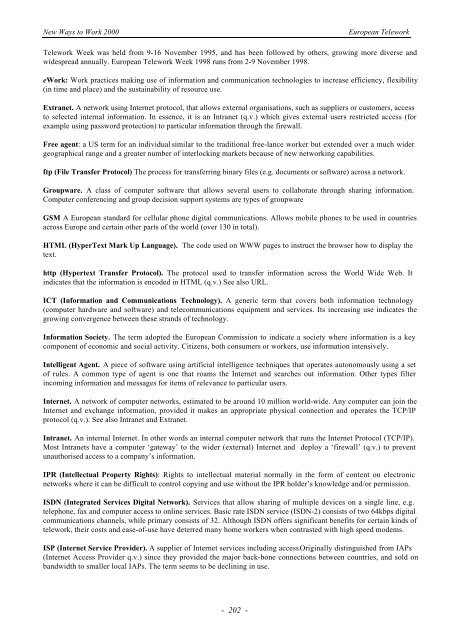eWORK 2000 - European Telework Week
eWORK 2000 - European Telework Week
eWORK 2000 - European Telework Week
- No tags were found...
You also want an ePaper? Increase the reach of your titles
YUMPU automatically turns print PDFs into web optimized ePapers that Google loves.
New Ways to Work <strong>2000</strong><strong>European</strong> <strong>Telework</strong><strong>Telework</strong> <strong>Week</strong> was held from 9-16 November 1995, and has been followed by others, growing more diverse andwidespread annually. <strong>European</strong> <strong>Telework</strong> <strong>Week</strong> 1998 runs from 2-9 November 1998.eWork: Work practices making use of information and communication technologies to increase efficiency, flexibility(in time and place) and the sustainability of resource use.Extranet. A network using Internet protocol, that allows external organisations, such as suppliers or customers, accessto selected internal information. In essence, it is an Intranet (q.v.) which gives external users restricted access (forexample using password protection) to particular information through the firewall.Free agent: a US term for an individual similar to the traditional free-lance worker but extended over a much widergeographical range and a greater number of interlocking markets because of new networking capabilities.ftp (File Transfer Protocol) The process for transferring binary files (e.g. documents or software) across a network.Groupware. A class of computer software that allows several users to collaborate through sharing information.Computer conferencing and group decision support systems are types of groupwareGSM A <strong>European</strong> standard for cellular phone digital communications. Allows mobile phones to be used in countriesacross Europe and certain other parts of the world (over 130 in total).HTML (HyperText Mark Up Language). The code used on WWW pages to instruct the browser how to display thetext.http (Hypertext Transfer Protocol). The protocol used to transfer information across the World Wide Web. Itindicates that the information is encoded in HTML (q.v.) See also URL.ICT (Information and Communications Technology). A generic term that covers both information technology(computer hardware and software) and telecommunications equipment and services. Its increasing use indicates thegrowing convergence between these strands of technology.Information Society. The term adopted the <strong>European</strong> Commission to indicate a society where information is a keycomponent of economic and social activity. Citizens, both consumers or workers, use information intensively.Intelligent Agent. A piece of software using artificial intelligence techniques that operates autonomously using a setof rules. A common type of agent is one that roams the Internet and searches out information. Other types filterincoming information and messages for items of relevance to particular users.Internet. A network of computer networks, estimated to be around 10 million world-wide. Any computer can join theInternet and exchange information, provided it makes an appropriate physical connection and operates the TCP/IPprotocol (q.v.). See also Intranet and Extranet.Intranet. An internal Internet. In other words an internal computer network that runs the Internet Protocol (TCP/IP).Most Intranets have a computer ‘gateway’ to the wider (external) Internet and deploy a ‘firewall’ (q.v.) to preventunauthorised access to a company’s information.IPR (Intellectual Property Rights): Rights to intellectual material normally in the form of content on electronicnetworks where it can be difficult to control copying and use without the IPR holder’s knowledge and/or permission.ISDN (Integrated Services Digital Network). Services that allow sharing of multiple devices on a single line, e.g.telephone, fax and computer access to online services. Basic rate ISDN service (ISDN-2) consists of two 64kbps digitalcommunications channels, while primary consists of 32. Although ISDN offers significant benefits for certain kinds oftelework, their costs and ease-of-use have deterred many home workers when contrasted with high speed modems.ISP (Internet Service Provider). A supplier of Internet services including access.Originally distinguished from IAPs(Internet Access Provider q.v.) since they provided the major back-bone connections between countries, and sold onbandwidth to smaller local IAPs. The term seems to be declining in use.- 202 -








